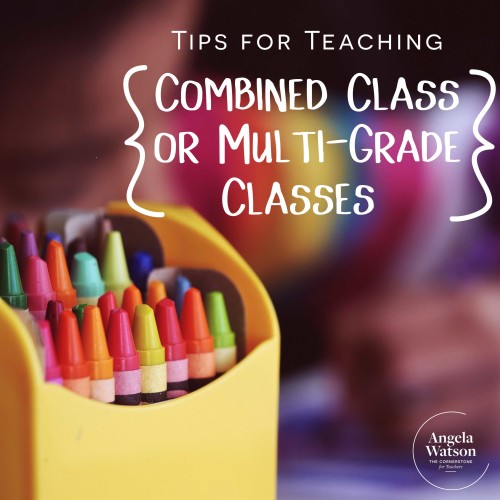
If you’re teaching a split class (multi-grade or combined class) and need advice on classroom management and organization, you’ve come to the right place! You’ll find practical tips from teachers who have taught in multi-level classrooms and combined classes at all different grade levels.

I’ve invited teacher-blogger Mary Mueller of Guided-Math to share more about her experience with teaching split classrooms. Thank you, Mary, for the helping tips!
Did you just find out you are teaching a split/combination/multi-age classroom? Are you in a bit of a panic mode trying to figure out how on earth you are going to handle two (sometimes more) grade levels at once?
Ten years ago, my teaching career began in a split classroom in a very large school district in Illinois. First of all, I can’t believe that I just wrote ten years! Secondly, now that I am counting, I can’t believe that seven of those years have been in combination classrooms! All of those questions and panic moments went through my head with the news of my first assignment. Back then, I never knew that first year, in a 1/2 split, would set me on a path of more split classrooms and would help positively shape who I am as a teacher today.
In the beginning, I saw combination teaching as a welcome challenge. This was a challenge that I was not going fail at. I was always looking at what I did and figuring out how I could make the structure better for both my students and I.
Throughout my years in 1/2, 2/3, 3/4 splits and three years in 4th grade, I realized that split teaching is really no different than a straight classroom. I found that I did not change how I taught or how I structured my day in a split classroom than I did for my straight grade.
Here are some things to think about when planning your combination classroom.
Good luck with your combination classroom teaching assignment! I know that you can and will succeed! For more information and to read more about how I structure my math or multi-age classroom check out my website, Guided-Math.
The following questions were submitted to me as part of the Ask Angela Anything blog post series. You can submit any teaching-related question anonymously to maintain your privacy and student confidentiality. I’m including the two questions below here on this page instead of in the column to make it easier for teachers of combined classes to find answers all in one place.
I am teaching a 2nd/3rd grade split. I’ve heard to call one level the juniors and the other level the seniors. My gut tells me not to start day one saying my 2nds or my 3rds but is it inevitable? What’s the best way to manage the classroom to create a team yet honor their grade levels? I don’t want any of my third graders to feel like they are still in second.
-Jane
Hi, Jane! There will be times when you need to refer to them by grade levels, and at those times, personally, I would call them second graders and third graders. But you can also let each grade level choose a name for themselves that reflects their unique identity as a class within a class. It can be part of your first week of school activities, kind of like some teachers do with reading groups. I think that would be a nice way to build a sense of community and give kids ownership over the classroom. They could also create a class name so they have one cohesive identity, too. For example, your whole class could be the whales, and your second graders could be the orcas and the third graders could be the belugas. Tell the kids about your dilemma on what to call them, and ask for their input! I bet they’ll come up with something way better than either of us could think of.

I have applied for a job in a combined 4/5 classroom and I have a good chance that I will get an interview. I don’t have any experience in multi-level rooms, I don’t even know what kinds of questions to ask, and, although I can see how the Cornerstone book could be a help with this type of classroom, is there anything that your book does not mention to help me organize for this type of room?
-J.
I would imagine that the 4th and 5th graders would work together on many assignments; you’d be able to differentiate your instruction and activities by ability level and not just grade level. This would probably be the way the principal would like it, judging by what I see in recent educational trends. If you would teach that way, then it would probably be helpful–in preparation for the interview–to come up with a few specific examples of how you would do this. In terms of organizing, you may need to keep some things separate (maybe different bins for them to turn in their papers, etc.) but for the most part I don’t think the grade level split would change much about the room layout.